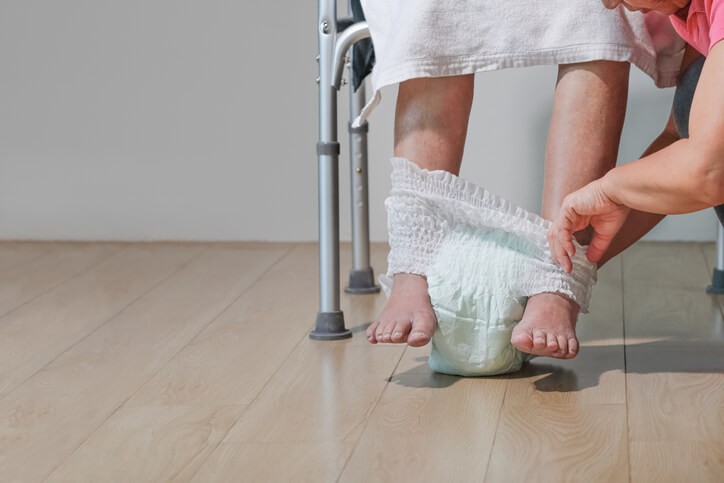
Contents
How Do You Care For An Incontinent Patient?
Incontinence is an involuntary loss of urine. You take care of an incontinent patient using home care, medications, alternative therapies, and surgery.
Incontinence affects almost 13 million Americans, especially older people. About 50% of elderly people living in a care facility or at home experience incontinence. Yet, not much is said about this personal issue and those it affects: the patients and the caregivers.
If you’re caring for a parent or relative with incontinence, approach the problem with sensitivity and help manage the condition while preserving dignity, comfort, and hygiene.
What is incontinence?
Incontinence is when you cannot control your bladder or bowel movements. You may become incontinent following surgery, childbirth, or with age. In America, more than 85% of people who suffer from incontinence are women. Men can also experience incontinence.
This condition can cause embarrassment, withdrawal from social gatherings, isolation, discomfort, and even prevent you from work. Due to the nature of the issue, tread lightly while discussing this sensitive topic with your patient or the person in your care.
Symptoms of incontinence
Common symptoms include:
- Leaking urine or feces without feeling an urge
- Leaking urine or feces when you lift, bend, cough, exercise, or laugh
- Sudden, uncontrollable urge to use the bathroom, followed immediately by urination
- Wetting the bed at night
Causes of incontinence
There are many reasons for incontinence. It could be a simple issue like side effects of medication or a more serious reason.
Common reasons for incontinence are:
- Recent surgery
- Multiple sclerosis (MS)
- Urinary tract infection (UTI)
- Irritable bowel syndrome (IBS)
- Pelvic floor organ prolapse
- Issues with the prostate
- Constipation
- Weakening of the pelvic floor
- Food allergies
- Alzheimer’s disease or dementia
Types of incontinence
There are several types of incontinence, such as:
- Stress urinary incontinence: Caused by an external stressor, such as lifting a heavy object or a sneeze, which suddenly causes urine to exit the body.
- Overactive bladder (OAB): Caused by a spasm in the bladder and a sudden urge to urinate with little or no warning.
- Neurogenic bladder: Happens when the nerves that control the bladder are damaged. This often creates bladder spasms and incomplete emptying.
- Urge incontinence: A sudden, uncontrollable urge to urinate, resulting in incontinence or leakage.
- Bowel incontinence (fecal): Feces or gas unexpectedly leaking from the rectum.
- Overflow incontinence: Usually caused by weak or non-functional bladder muscles. The bladder never fully empties, and there is no urge to urinate.
- Functional incontinence: Occurs when inability to move impairs reaching the bathroom in time or at all.
People can suffer from a combination of these types of incontinence.
Diagnosing incontinence
Incontinence can happen for many different reasons. That’s why it’s important to talk to your doctor about the cause as soon as you notice it’s a problem. They will ask you questions about recent surgery, medication, or new symptoms you may have noticed.
They will collect a urine sample to analyze at a laboratory (urinalysis) to see if there are any clues to what’s causing the incontinence. The doctor may also suggest other diagnostic methods, such as:
- X-ray
- Blood chemistry test
- Cystoscopic exam
Once the cause is identified, they can diagnose the type of incontinence and tell you if it’s reversible or chronic.
Treatments for incontinence
Your healthcare provider may prescribe a combination of medication, behavioral techniques, and exercises to help strengthen the pelvic floor muscles. They will typically try the least invasive treatments first before moving on to other options.
Medications
Medications typically used for incontinence care are:
- Alpha blockers
- Anticholinergics
- Topical estrogen creams or patches
- Mirabegron
Your doctor will be able to tell you what type of medication and therapy will work best for you.
Home care
There are plenty of products available to make your life easier at home:
- Disposable underwear
- Protective bed sheets and furniture covers
- Incontinence pants
- A small commode in the bedroom
Skin care while experiencing incontinence is important too. People who sit with urine or feces for any amount of time are prone to skin irritation, rashes, and other skin problems. Clean up any bouts of incontinence immediately. Urine and feces can break down the skin over time, causing infection.
- Use these skin tips when caring for someone with incontinence:
- Use gentle soap and water when cleaning.
- Avoid antibacterial soaps as they can be harsh on sensitive skin.
- Don’t use talc powders or products with fragrance, as they can hold moisture against the skin.
- Air dry the skin when possible.
- Gently wash the area morning and night, even if no incontinence has occurred.
Your doctor may recommend performing exercises to strengthen your pelvic floor. These can be extremely useful over time in preventing bouts of incontinence.
Alternative therapies
Devices are available to help control incontinence. They can be categorized as:
- Devices that prevent incontinence: Urethral inserts, anal plugs, or intravaginal devices such as a pessary.
- Devices that collect or contain incontinence: Catheters and urinary or anal pouches collect and store waste until the receptacle is changed.
Surgery
Surgery is available to treat incontinence. Your healthcare provider may recommend one of these surgeries as a last resort if other therapies haven’t worked:
- Colposuspension: A small incision is made in the lower abdomen to lift the neck of the bladder. The bladder is then stitched into a lifted position.
- Sling surgery: Tissue taken from yourself or a donor is placed around the neck of the bladder or urethral bulb to support the bladder.
- Artificial urinary sphincter: Your sphincter is a muscular ring that prevents urine from leaving the bladder through the urethra. If your sphincter muscle isn’t working properly, surgery to position an artificial sphincter muscle around your bladder is possible.
- Prolapse surgery: Prolapse surgery repositions the pelvic floor organs so they function properly again. It’s sometimes done at the same time as sling surgery.
Potential risks of incontinence treatments
There are many alternative options available for people who suffer from incontinence. Whether your incontinence is reversible or chronic, your doctor will discuss the proper form of treatment and its potential risks.
Talk to your doctor about any potential side effects from medication they may prescribe for incontinence.
American Family Physician: "Diagnosis of Urinary Incontinence."
American Family Physician: "Selecting Medications for the Treatment of Urinary Incontinence."
Elder: "Helping with personal care and elderly incontinence."
Illinois Department of Public Health: "Facts About Incontinence."
National Health Service: "Urinary incontinence — Surgery and procedures."
National Institute of Diabetes and Digestive and Kidney Diseases: "Symptoms & Causes of Bladder Control Problems (Urinary Incontinence)."
Nursing Research: "Managing Incontinence Using Technology, Devices, and Products: Directions for Research."
The Simon Foundation for Continence: "Incontinence: Guidance for the At Home Caregiver."
The Simon Foundation for Continence: "Incontinence: Guidance for the At Home Caregiver."


